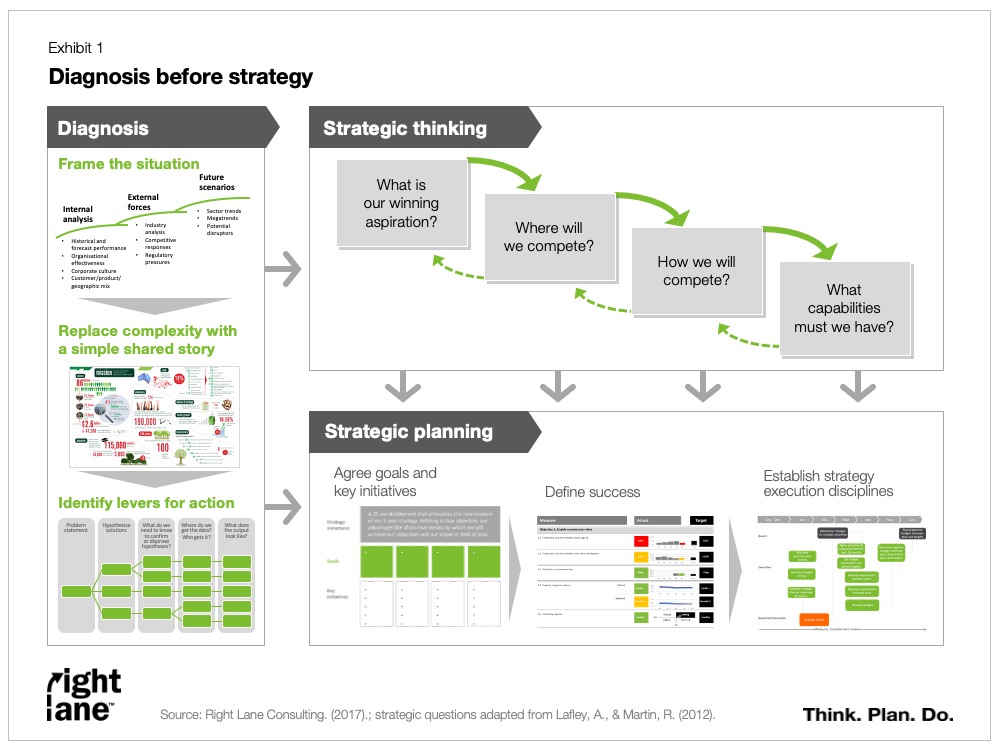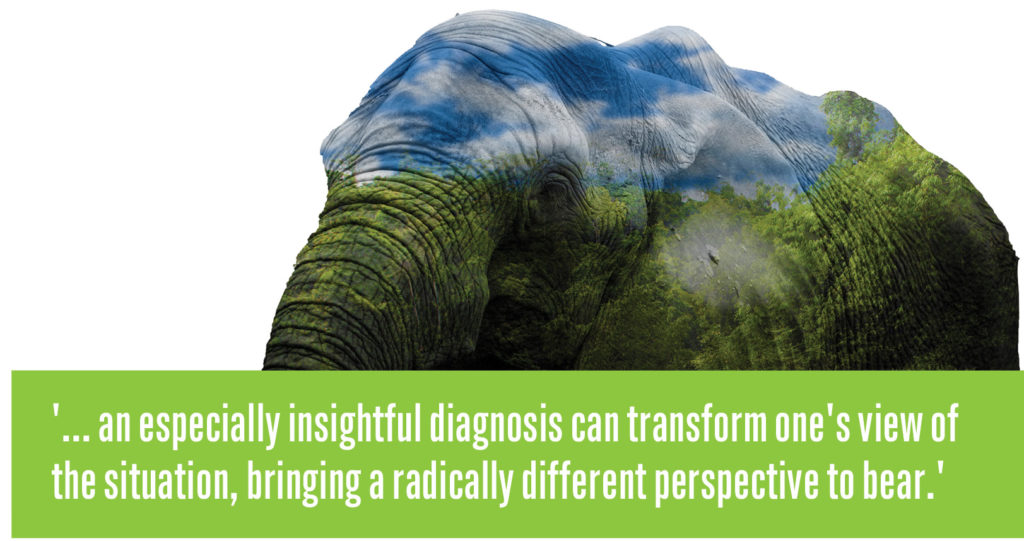The value of a robust diagnosis: be better prepared for this year’s council planning process
by Zoe Pappas & Jess Cossens
Right Thinking
As council plans are due for review in the coming months in Victoria, Right Lane recommends councils invest time in a diagnosis of their strategic context to inform upcoming decisions. This may include analysis of the external environment, trends impacting their communities and a review of current operations.
A robust diagnosis serves 3 purposes. Firstly, it helps uncover new and valuable insights. Secondly, it allows for fact-based decision making. And thirdly, it helps align new councillors and decision makers to current commitments and plans.
A well-developed diagnosis allows councils to adopt an evidence-based approach to strategic decision-making; improving outcomes for the future of local communities.
This briefing will be most relevant to council CEOs and executives responsible for delivering local government objectives who are seeking to produce greater impact from their council planning process.
Right Lane is proud to be partnering with LGiU to share our experience and knowledge with the local government network through a series of published articles. You can find our first LGiU published article (member only access) article ‘Strategic impact for local government: 5 ways to ‘power up’ your council strategic planning process’ HERE and this second article HERE.
LGiU Australia is a local government think tank, established by LGiU in partnership with SGS Economics and Planning. To register for LGiU Australia updates and access all content, contact SGS Principal and Partner Luke Nicholls.
See more of Right Lane’s local government experience HERE
As council planning season approaches in Victoria, it is an opportune time for CEOs to consider how to get the most out of the council planning process. Developing an impactful council plan requires strategic thinking about our long-term vision for our community, and strategic planning around actions for the coming 4 years.
Undertaking robust analyses of what’s happening in the world, in our communities, and within our council as an organisation is critical for councils to build an evidence base and a common reference point to draw upon when engaging in strategic thinking and strategic planning. At Right Lane, we suggest that councils start their strategy process by investing time in a diagnosis that sorts data into patterns, and replaces the overwhelming complexity of available analyses with a simple story, from which levers for action can be identified.
Diagnosis before strategy
At Right Lane, we describe our approach to strategy development in 2 parts. We ask clients to spend time ‘upstairs’ thinking about challenging strategic questions like: What do we exist to do? How can we best meet the unique needs of our evolving community? And what capabilities do we need to build? Once these questions have been satisfactorily answered, we ‘move downstairs’ into strategic planning discussions covering shorter-term goals, measures and priority initiatives.
While these 2 steps are critically important they are generally not sufficient on their own. Preceding strategic thinking and planning we would encourage councils to undertake robust analyses of what’s happening in the world, their communities and their organisations, so that they have an evidence base and a common reference point to draw upon. This should include an acknowledgement of the strategic work that has gone before this planning period: a review of the existing community vision (which may have been developed several years earlier), an appraisal of strategic projects for which the council is already committed, and an assessment of work completed against the last council plan. As outlined in the exhibit 1.
While this sounds obvious enough, in our experience we’ve found that it’s not uncommon for the analysis phase to be foregone or given short shrift. Leaders don’t always see the value in it. Why? Common reasons we’ve heard include: ‘Only recently one of the executive team has done some strategic analysis’; ‘a consulting firm’s report includes a section on industry analysis’; ‘an external report or some market research covers some of the ground’; ‘our councillors and senior teams already know what they need to know’.
This reminds us of the Indian parable of four blind men walking through a forest who come across an elephant. Each blind man feels a different part of the elephant’s body and describes the elephant based on their experience. One feels the trunk and describes it as a snake, another feels a leg and describes it as a pillar. What happens next depends on who is telling the story. In some versions, the men suspect the others and come to blows. In another version, they stop talking, start listening and collaborate to ‘see’ the full elephant.
Richard Rumelt, in his book Good strategy, bad strategy, calls this analysis a diagnosis and notes that ‘an especially insightful diagnosis can transform one’s view of the situation, bringing a radically different perspective to bear’. And with radically different perspectives can come different opportunities.
Consider these examples:
- Long-term trends in a council’s financial performance highlighted the need to modify its service model in a shorter timeframe than previously thought.
- A review of existing council commitments and forecast revenues demonstrated that the ‘budget envelope’ for new expenditure was larger than anticipated.
- A regional council recognised that if drought and climate patterns persisted the impact would be felt not only on their agricultural industry but on the socio-cultural feel of their community, opening up opportunities for new engagement and activities.
- Assumptions about the future demographic profile and revenue projections for a given municipality needed to be altered to consider the impact of coronavirus, in the immediate term and over the coming years, with implications for service delivery.
The threefold value of a robust diagnosis
We see the value of a robust diagnosis in 3 dimensions. Firstly, a thorough review of the external environment and internal operations provides opportunities to uncover insights that have a significant impact on the strategic direction of your council. Often, when working with councillors and other key decision makers, we ask ‘what do you wish you knew?’ as a starting point for investigation. For some councils this may be demographic and socio-economic trends in their region, for others it might be environmental forecasts, and for others it may be important to understand the current cost breakdown of council operations.
Secondly, by conducting an investigation into these areas and developing a concise diagnosis, councillors and executive teams are able to make decisions based on fact rather than gut feeling. As local governments know, when spending public funds it’s important that appropriate due diligence is done. This is equally important down the track when demonstrating the ‘why’ of key decisions made during the planning process; any good change process requires clear communication of why a change is being made, and being able to point to a fact base to support that change is a critical component.
Finally, a diagnosis document can help align decision-makers to a single source of truth. Conversations with our council clients indicate that around half of Victorian councillors will turn over each election cycle, so there will be a significant number of new faces present at each planning process. A well-crafted diagnosis can help set the strategic context before new decisions are explored. For example, it’s critically important for decision makers to have a shared understanding of the previous community vision, to acknowledge current resource commitments, and to have visibility over the current performance and trajectory of their council before seeking to commit to future actions.
Worth the investment?
Some council representatives we’ve spoken to are unsure of the merits of investing in a thorough diagnosis. We would ask those representatives to consider these questions:
- Is there an opportunity to identify a handful of hitherto unknown, strategically material insights among the overwhelming morass of analysis that is available within your council?
- Will all councillors and council executives bring the same understanding of the organisation’s performance and health, situation and prospects to the council planning discussion?
- Does your council have a contemporary ‘house view’ about how changes in the world will impact council operations, priorities and resources?
Each local government will need to develop a tailored diagnosis to suit their specific needs. This would likely include some combination of internal performance analysis (review of existing strategies, historical and forecast financial performance, review of staff surveys and metrics); review of external factors (changing demographic data, community profiles and needs analysis, regulatory changes); and an exploration of future trends (potential disruptors, sector trends and potential scenarios).
Adopting an evidence-based approach to developing council plans provides a framework for discussing those more difficult issues within council chambers. One that links data into patterns and replaces the overwhelming complexity of reality with a simple story from which levers for action can be identified.
As council planning season is fast approaching in Victoria, the diagnostic processes discussed in this briefing provides councils with a valuable tool for articulating their strategic context and aligning decision makers in preparation for council planning.
References
Adapted from Williams, D., Chhikara, A., & Levy, M. (2017, December). The value of a robust diagnosis – be better prepared for next year’s strategy and planning process. Right Lane Review.
Lafley, A., & Martin, R. (2012). Playing to win: How strategy really works. Harvard Business Review Press.
Rumelt, R. (2011). Good strategy, bad strategy: The difference and why it matters. Crown Business.
If this article was helpful, you may also be interested in the following articles:
Strategic impact for local government: 5 ways to ‘power up’ your council strategic planning process
Beyond the council plan – creating impact with a corporate plan
See more of Right Lane’s local government experience HERE
We hope the ideas presented here have given you something new to think about. We would love the opportunity to discuss them with you in more detail. Get in touch today.



